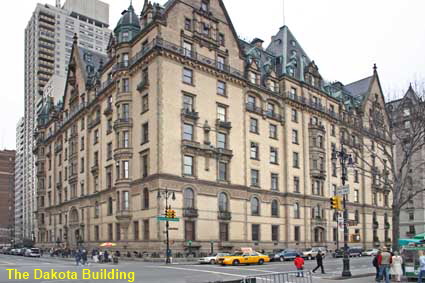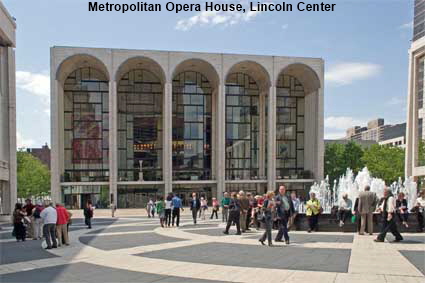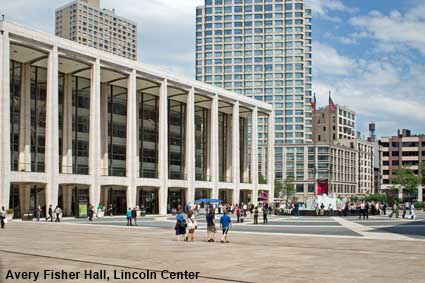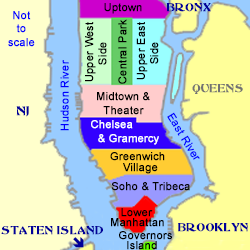Upper West Side
The area between the Hudson River and Central Park is known as the Upper West Side. In colonial times, it was mainly a farming area, with a few mansions used as country retreats by well off New Yorkers. In the late 19th century, the river front became industrialised, and inland residential development began to turn the Upper West Side into a suburb of the city. The arrival of the Subway in 1904 increased the pace of development. Both Upper East and West Sides are nowadays expensive places to live, but while residents of the Upper East Side are perceived to be well off business people, the Upper West Side tends to be associated with people working in the Arts and Media.
Avery Fisher Hall, Lincoln Center
By the mid 1950s the Lincoln Square area had become run down. A group of civic leaders led by John D. Rockefeller III came up with a plan to develop the area as a major arts and cultural centre. Work began on the Lincoln Center in 1959 with a ground breaking ceremony performed by President Dwight D. Eisenhower. In 1962 a 2,738 seat concert hall opened as the new home of the New York Philharmonic. It was called Philharmonic Hall until 1973 when it was renamed in honour of Avery Fisher after he made a $10.5m donation to the orchestra.
Metropolitan Opera House, Lincoln Center
The Metropolitan Opera House opened on Broadway and 39th Street back in 1883. The Lincoln Center was to provide a new home for the Metropolitan Opera, a 3,900 seat opera house that opened in 1966. The new opera house was designed by architect Wallace K. Harrison of Harrison & Abramovitz.
Click on Minimap to navigate
The Dakota Building
While the east side of Central Park is known for mansions and museums, the west side is better known for luxurious apartment blocks. The Dakota Building was the first, built at 72nd Street between 1880 and 1884. It was designed by architect Henry J. Hardenbergh for Edward S. Clark, head of the Singer Sewing Machine Company. At the time the area was still mainly occupied by poor farmers and the name is thought to reflect the fact that the Upper West Side at that time seemed as remote and undeveloped as the Dakota Territories. One famous resident of the Dakota Building was John Lennon who was murdered on the steps of the building in 1980. The memorial to Lennon in Central Park is just across the road.



DLU170611


To move forwards or backwards through the Manhattan trail click the arrows above, or select your next destination on the Minimap.
South Facade, American Museum of Natural History
In 1869 American naturalist Albert Smith Bickmore put forward a proposal to create a Natural History Museum in New York City. His proposal was backed by a number of influential people including Theodore Roosevelt, Senior, the father of President Theodore Roosevelt. On April 6 that year New York Governor John Thompson Hoffman signed a bill officially creating the American Museum of Natural History. The museum opened in 1871 in the Arsenal Building in Central Park, but quickly outgrew the space available. In 1872 the museum bought a block of land to the west of Central Park between West 77th and 81st Streets. It did not then have the funds to build a museum that would fill the site but a modest building on one corner of the site opened in 1877. The next stage of the museum had a neo-Romanesque facade with grand entrance running along 77th Street, as shown here. In 1936 a new entrance opened on Central Park West, opening on to a Theodore Roosevelt Memorial Hall. That became the main entrance to the museum but you can still exit the museum through the doors on the south facade. Natural History Museums are places where you expect to see fossils and stuffed animals, but the American Museum of Natural History covers other subjects such as Human Culture. There a large hall on the ground (first) floor dedicated to the Northwest Coast Indians. Click Tab 2 to see the Hall of the Northwest Coast Indians inside the museum. Click Tab 3 to see a display of Alaska Brown Bears.

Ahnighito Meteorite, American Museum of Natural History
The natural history of the earth is moulded by events far beyond it and the museum reflects this. The Rose Center for Earth and Space which opened in 2000 has a planetarium and cosmic pathway. In the old museum building, is the Arthur Ross Hall of Meteorites which includes the Ahnighito Meteorite. Around 10,000 years ago a large meteorite landed in Savissivik on Meteorite Island, Greenland. This 31 tonne (34 ton) part of the meteorite was called Ahnighito (the Tent) by the local Inuit. It was located by US explorer Robert E. Peary in 1894, and a few years later he recovered this and other pieces of the meteorite, which he sold to the American Museum of Natural History. Looking at the size of it, it must have come down with quite a bang!



© Mike Elsden 1981 - 2025
The contents of this page may not be reproduced in full or in part without permission